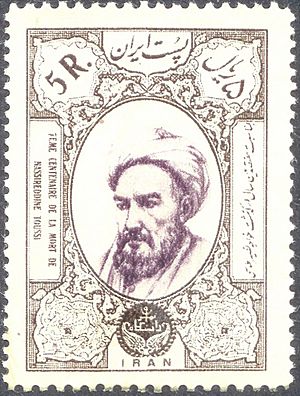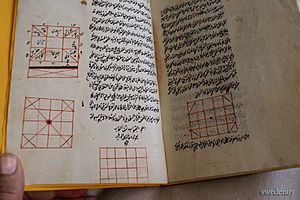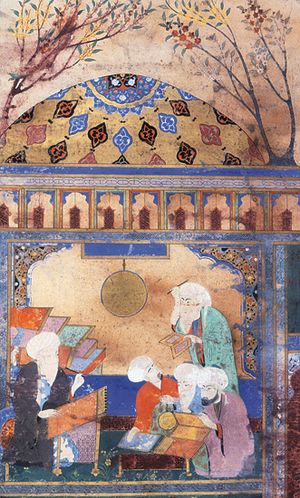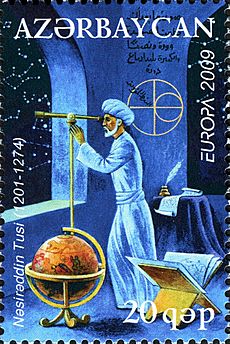Nasir al-Din al-Tusi facts for kids
Quick facts for kids Nasīr al-Dīn Tūsī |
|
|---|---|
| نصیرالدین طوسی | |

Iranian stamp for the 700th anniversary of his death
|
|
| Religion | Islam |
| Denomination | Shia |
| Personal | |
| Born | 18 February 1201 Tus, Khurasan, Khwarazmid Empire |
| Died | 26 June 1274 (aged 73) Al-Kadhimiya Mosque, Kadhimiya, Baghdad, Ilkhanate |
| Senior posting | |
| Title | Khawaja Nasir |
| Religious career | |
| Students | Shams al-Din al-Bukhari |
| Works | Tajrid al-I'tiqad, Zij-i ilkhani, Rawḍa-yi Taslīm, Akhlaq-i-Nasri, al-Risalah al-Asturlabiyah, Al-Tadhkirah fi 'Ilm al-Hay'ah (Memoir on the Science of Astronomy) |
| Influenced | Maitham Al Bahrani, ibn Khaldun, Qutb al-Din Shirazi, Ibn al-Shatir, Copernicus |
Nasir al-Din al-Tusi (born Muhammad ibn Muhammad ibn al-Hasan al-Tūsī; 18 February 1201 – 26 June 1274) was an amazing Persian scientist, philosopher, and writer. He was known as a "polymath," meaning he was an expert in many different subjects.
Tusi made huge contributions to math, science, and philosophy. He is often called the creator of trigonometry as its own field of study. He also made important discoveries in astronomy, mathematics, biology, and chemistry. Many people consider him one of the greatest scientists of the medieval Islamic world. Some even believe his ideas influenced famous European scientists like Nicolaus Copernicus.
Contents
Life Story of Nasir al-Din al-Tusi
Nasir al-Din al-Tusi was born in 1201 in a city called Tus in what is now northeastern Iran. He started learning at a very young age. He studied many subjects like the Quran, logic, philosophy, mathematics, medicine, and astronomy.
He grew up in a Shī‘ah family and sadly lost his father when he was young. To honor his father's wish, Tusi took his studies very seriously. He traveled far to learn from famous scholars, which was encouraged in his Islamic faith. He went to Nishapur to study philosophy and mathematics. He also met a famous Sufi master named Attar of Nishapur.
In Mosul, Tusi studied math and astronomy with Kamal al-Din Yunus. Later, he wrote a small book about philosophical Sufism called Awsaf al-Ashraf.
Tusi and the Mongol Invasion
When the armies of Genghis Khan swept through his homeland, Tusi worked for the Nizari Ismaili state. He moved between their strongholds and made many important scientific discoveries during this time. He was later captured by the Mongol forces led by Hulagu Khan.
Tusi's autobiography, The Voyage, explains that losing books, like when the Alamūt libraries were destroyed in 1256, did not break the spirit of the Nizari Ismaili community. They believed in the importance of a "living book" (their leader, the Imam) more than just written words.
Role During the Siege of Baghdad
In 1256, Tusi was at the Alamut castle when it was attacked by Hulagu Khan's forces. Some stories say that Tusi helped the Mongols. After the Mongols destroyed Alamut, Hulagu Khan, who was interested in science, treated Tusi with great respect. He made Tusi his scientific adviser.
It is widely believed that Tusi was with the Mongol forces when they attacked Baghdad in 1258. After the attack, he was given control over the money for religious groups. He visited many Shi'ii holy places. Being in a powerful position, Tusi helped spread the Twelver Shia faith across Persia and Iraq.
Important Writings and Books
Tusi wrote about 150 books and papers. Most of them were in Arabic, but 25 were in Persian. He even wrote one paper in Persian, Arabic, and Turkish.

Here are some of his well-known works:
- Sayr wa-Suluk (The Voyage) - This was his autobiography.
- Kitāb al-Shakl al-qattāʴ - A five-volume book about trigonometry.
- Al-Tadhkirah fi'ilm al-hay'ah - A book about astronomy.
- Akhlaq-i Nasiri - A famous book about ethics and good behavior.
- al-Risalah al-Asturlabiyah - A book about the astrolabe, a tool used in astronomy.
- Zij-i Ilkhani (Ilkhanic Tables) - A major book of astronomical tables, finished in 1272.
- Tajrīd al-Iʿtiqād (Summation of Belief) - A book explaining Shia beliefs.
Tusi also wrote poems. Here is an example:
Anyone who knows, and knows that he knows,
makes the steed of intelligence leap over the vault of heaven.
Anyone who does not know but knows that he does not know,
can bring his lame little donkey to the destination nonetheless.
Anyone who does not know, and does not know that he does not know,
is stuck forever in double ignorance.
Amazing Achievements
Tusi became known as an amazing scholar during his time in Nishapur. His many writings cover both religious and scientific topics. He also created important Arabic versions of works by famous Greek thinkers like Euclid, Archimedes, and Ptolemy.
Astronomy Discoveries
Tusi convinced Hulagu Khan to build an observatory to create more accurate tables for predicting the positions of stars and planets. The Rasad Khaneh observatory was built in 1259 in Azarbaijan.
Using observations from this advanced observatory, Tusi made very precise tables of planetary movements. These were written in his book Zij-i ilkhani (Ilkhanic Tables). This book helped people calculate where planets and stars would be. His model of the solar system was considered the most advanced of his time. It was used a lot until Nicolaus Copernicus developed his heliocentric model.
Tusi invented a special geometric trick called a Tusi-couple. This trick uses two circular motions to create a straight line motion. He used this to improve on Ptolemy's older models for planets. The Tusi couple was later used in models by other astronomers, including Copernicus. Tusi also calculated how much the equinoxes shift each year. He helped build and use astronomical tools like the astrolabe.
Tusi also had ideas about the Milky Way. He wrote that it is made of "a very large number of small, tightly-clustered stars." He said they look like cloudy patches because they are so concentrated and tiny. Three centuries later, Galileo Galilei used a telescope to prove that the Milky Way is indeed made of countless faint stars.
Logic and Reasoning
Nasir al-Din Tusi supported the ideas of Avicenna in logic. He wrote comments on Avicenna's ideas about how statements are true or false.
Mathematics Breakthroughs
Al-Tusi was the first to write a book about trigonometry as its own subject, separate from astronomy. In his Treatise on the Quadrilateral, he explained spherical trigonometry in great detail. Thanks to Tusi, trigonometry became its own important part of pure mathematics.
He was also the first to list the six different types of right triangles in spherical trigonometry. In his book On the Sector Figure, he included the famous law of sines for flat triangles:
He also explained the sine law for spherical triangles and found the law of tangents for spherical triangles.
Understanding Colors
Tusi also thought about how colors work. While earlier thinkers suggested colors were on a line from black to white, Tusi said there were at least five different paths from black to white. These paths went through colors like lemon (yellow), blood (red), pistachio (green), indigo (blue), and grey. This idea helped people understand color as having more than one dimension.
Biology and Life
In his book Akhlaq-i Nasiri, Tusi wrote about several topics in biology. He supported an idea similar to Aristotle's "ladder of nature," where he placed humans above animals, plants, minerals, and elements.
He described how plants grow from simple elements. He thought the date-palm was the most advanced plant because it was almost like an animal, only needing to move to find food.
He said the simplest animals are like plants, reproducing without mating, such as earthworms. More advanced animals have "fully developed weapons" like antlers or claws. Tusi saw these body parts as ways animals adapted to their lives.
He also wrote about learning:
"The noblest of the species is that one whose sagacity and perception is such that it accepts discipline and instruction... Such are the schooled horse and the trained falcon. The greater this faculty grows in it, the more surpassing its rank, until a point is reached where the (mere) observation of action suffices as instruction: thus, when they see a thing, they perform the like of it by mimicry, without training... This is the utmost of the animal degrees, and the first of the degrees of Man in contiguous therewith."
Here, Tusi described different ways of learning. He saw observational learning (learning by watching) as the most advanced, and he correctly said that some animals can do this. Tusi seemed to think humans were part of the animal kingdom, but with a special "Human Soul" that made them unique.
Some experts think Tusi's writings on biology hinted at a kind of evolutionary theory. However, he didn't clearly say that species change over time.
Chemistry and Mass
Tusi also contributed to chemistry. He wrote about an early idea similar to the conservation of mass, which means that matter cannot be created or destroyed.
Philosophy and Ethics
Tusi wrote many important works on philosophy. One of his most famous philosophical books is Nasirean Ethics. In this book, he discussed and compared Islamic teachings with the ideas of Aristotle and Plato. Tusi's book became a very popular book on ethics in the Muslim world. His book Targid was also very important in Shi'ite Islamic theology.
Legacy and Impact
A 60-kilometer wide crater on the moon is named "Nasireddin" after him. A small planet discovered in 1979 is named 10269 Tusi. The K. N. Toosi University of Technology in Iran and an observatory in Azerbaijan are also named after him. In 2013, Google celebrated his 812th birthday with a special "doodle" on its website. His birthday is also celebrated as Engineer's Day in Iran.
Did Tusi Influence Copernicus?
Some scholars believe that the famous European astronomer Nicolaus Copernicus might have been influenced by Middle Eastern astronomers, including Nasir al-Din al-Tusi. This is because there are surprising similarities between Copernicus's work and the ideas of these Islamic scholars, even though Copernicus didn't mention them.
For example, the Tusi couple (Tusi's geometric trick) is very similar to a method Copernicus used in his astronomy. Not only do the methods look alike, but they even use the same letters for the points in their diagrams. This makes some people think it might be more than a coincidence.
There's no direct proof that Copernicus saw Tusi's original work. However, there is evidence that scientific ideas traveled from the Middle East to Europe. Jewish scientists and travelers sometimes carried these ideas. Also, ideas from the Islamic school in Maragheh, where Tusi's observatory was, could have spread through Muslim Spain or through Greek translations.
Despite these similarities, there is no direct proof that Copernicus copied Tusi's work. Some scholars argue that the Tusi couple is not a unique idea. They say that Copernicus, who was unhappy with older astronomy models, could have figured out the same geometric solution on his own using Euclid's principles.
See also
 In Spanish: Nasir al-Din al-Tusi para niños
In Spanish: Nasir al-Din al-Tusi para niños




